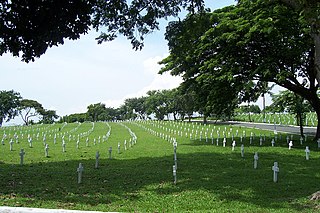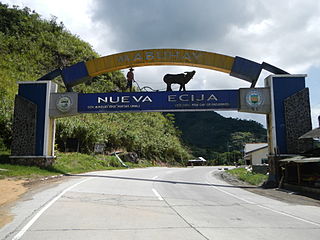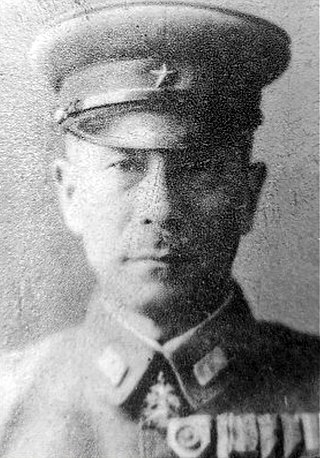
Camp John Hay is a mixed-used development which serves as a tourist destination and forest watershed reservation in Baguio, Philippines which was formerly a military base of the United States Armed Forces.

Ifugao, officially the Province of Ifugao, is a landlocked province of the Philippines in the Cordillera Administrative Region in Luzon. Its capital is Lagawe and it borders Benguet to the west, Mountain Province to the north, Isabela to the east, and Nueva Vizcaya to the south.

Victory over Japan Day is the day on which Imperial Japan surrendered in World War II, in effect bringing the war to an end. The term has been applied to both of the days on which the initial announcement of Japan's surrender was made – 15 August 1945, in Japan, and because of time zone differences, 14 August 1945 – as well as to 2 September 1945, when the surrender document was signed, officially ending World War II.

Tomoyuki Yamashita was a Japanese convicted war criminal and general in the Imperial Japanese Army during World War II. Yamashita led Japanese forces during the invasion of Malaya and Battle of Singapore, his conquest of Malaya and Singapore in 70 days earned him the sobriquet "The Tiger of Malaya" and led to the British Prime Minister Winston Churchill calling the ignominious fall of Singapore to Japan the "worst disaster" and "largest capitulation" in British military history. Yamashita was assigned to defend the Philippines from the advancing Allies later in the war. Although he was unable to prevent the superior Allied forces from advancing, despite dwindling supplies and Allied guerrilla action, he was able to hold on to part of Luzon until after the formal Surrender of Japan in August 1945.

The indigenous peoples of the Cordillera in northern Luzon, Philippines, often referred to by the exonym Igorot people, or more recently, as the Cordilleran peoples, are an ethnic group composed of nine main ethnolinguistic groups whose domains are in the Cordillera Mountain Range, altogether numbering about 1.8 million people in the early 21st century.

Libingan ng mga Bayani is a national cemetery within Fort Andres Bonifacio in Taguig City, Philippines.

Kiangan, officially the Municipality of Kiangan is a 4th class municipality in the province of Ifugao, Philippines. According to the 2020 census, it has a population of 17,691 people.

Mayoyao, officially the Municipality of Mayoyao is a 4th class municipality in the province of Ifugao, Philippines. According to the 2020 census, it has a population of 15,621 people.

The Manila massacre, also called the Rape of Manila, involved atrocities committed against Filipino civilians in the City of Manila, the capital of the Philippines, by Japanese troops during the Battle of Manila which occurred during World War II. At least 100,000 civilians were killed in total during the battle from all causes including the massacre by Japanese troops.

Mount Samat National Shrine or Dambana ng Kagitingan is a historical shrine located near the summit of Mount Samat in the town of Pilar, Province of Bataan, in the Philippines. The memorial shrine complex was built to honor and remember the gallantry of Filipino and American soldiers who fought against the Imperial Japanese Army during World War II.

John Hay Air Station, more commonly known as Camp John Hay, was a military installation in Baguio, Philippines.

Camp O'Donnell is a currently military base and former United States military reservation in the Philippines located on Luzon island in the municipality of Capas in Tarlac. It housed the Philippine Army's newly created 71st Division and after the Americans' return, a United States Army camp. During World War II, the reservation was used as a prisoner-of-war camp for Filipino and American soldiers captured by Japan during its successful invasion of the Philippines. About 60,000 Filipino and 9,000 Americans were housed at the camp. During the few months in 1942 that Camp O'Donnell was used as a prisoner-of-war camp, about 20,000 Filipinos and 1,500 Americans died there of disease, starvation, neglect, and brutality.

The Capas National Shrine in Barangay Aranguren, Capas, Tarlac, Philippines was built by the Philippine government as a memorial to Allied soldiers who died at Camp O'Donnell at the end of the Bataan Death March during the Second World War.

The Philippine Veterans Affairs Office (PVAO) is the Philippine agency for Filipino war veterans. Under the Department of National Defense, PVAO serves to fulfill a national commitment as embodied in Section 7, Article XVI of the 1987 Philippine Constitution:

Dalton Pass, also called Balete Pass, is a zigzag road and mountain pass that joins the provinces of Nueva Ecija and Nueva Vizcaya, in central Luzon island of the Philippines. It is part of Cagayan Valley Road segment of Pan-Philippine Highway.

Shigenori Kuroda was a Japanese lieutenant general of the Japanese Imperial Army and the Japanese Governor-General of the Philippines during World War II.

During the Japanese occupation of the islands in World War II, there was an extensive Philippine resistance movement, which opposed the Japanese and their collaborators with active underground and guerrilla activity that increased over the years. Fighting the guerrillas – apart from the Japanese regular forces – were a Japanese-formed Bureau of Constabulary, the Kenpeitai, and the Makapili. Postwar studies estimate that around 260,000 people were organized under guerrilla groups and that members of anti-Japanese underground organizations were more numerous. Such was their effectiveness that by the end of World War II, Japan controlled only twelve of the forty-eight provinces.
The Battle of Mayoyao Ridge was part of the Philippines campaign of 1944–1945 during World War II.
The Philippine War Crimes Commission was a commission created in late 1945 by General Douglas MacArthur as Supreme Commander of the Allied Powers to investigate the war crimes committed by the Imperial Japanese Army and Imperial Japanese Navy during the invasion, occupation, and liberation of the Philippines. The investigation by the Commission led to the extradition, prosecution, and conviction of Class A, Class B, and Class C defendants in Manila, Tokyo, and other cities in East and Southeast Asia through the International Military Tribunal for the Far East.


















